Prerequisites (Apple Pay)
Apple Pay supports third-party browsers such as Google Chrome for users with iOS 18 or higher.
Use this guide to prepare and configure Apple Pay with Yuno.
- Apple Developer prerequisites: Create a merchant ID, generate and convert the required certificates/keys, and verify your merchant domains.
- Yuno Dashboard setup: Add the Apple Pay connection, set up routing, and enable Apple Pay in Checkout Builder.
When finished, you'll be ready to choose your integration path (SDK or Direct) for one-time and recurring payments.
Step 1: Register a merchant identifier
If you're using VTEX as your e-commerce platform, you'll need to configure your Apple Pay Merchant ID. For detailed instructions, check out the official VTEX documentation.
In the Apple Developer dashboard:
- Log in to Apple Developer, go to Certificates, Identifiers & Profiles, then select Register a new identifier.
- Choose Merchant IDs.
- Enter a Description (e.g.,
Apple Pay Integration) and an Identifier in the formatmerchant.com.y.uno.YourBusinessName.
Step 2: Generate a payment processing certificate
- Create a new directory (e.g.,
Downloads/ApplePayFiles) to store the certificate files. - Open Keychain Access on your Mac.
- Go to Keychain Access > Certificate Assistant > Request a Certificate From a Certificate Authority.
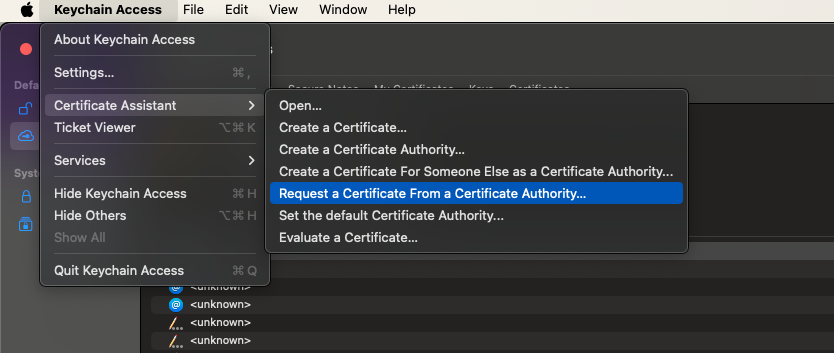
-
Fill out the form:
- Email Address: your email address
- Common Name: a name for the certificate (e.g.,
John Doe ProcessingCertificate) - CA Email Address: leave blank
- Select Saved to disk
- Check Let me specify key pair information
-
Click Continue, then save the file as
CertificateSigningRequestPaymentProcessingCertificate.certSigningRequestin your working directory. -
When prompted for key pair settings, use:
- Key Type: Elliptic Curve (EC)
- Key Size: 256-bit
- Algorithm: ECDSA
Step 3: Retrieve and convert the payment processing certificate
- Go to the Apple Developer Merchant ID list.
- Select your Merchant ID and click Create Certificate under Apple Pay Payment Processing Certificate.
- When prompted, answer No to "Will payments... be processed exclusively in China mainland?"
- Upload the file
CertificateSigningRequestPaymentProcessingCertificate.certSigningRequest. - Download the signed certificate as
apple_pay.cerand save it to your directory. - Convert the certificate to PEM format:
openssl x509 -inform DER -in apple_pay.cer -out apple_pay.pemStep 4: Export the private key
- In Keychain Access, find the key you created (e.g.,
John Doe ProcessingCertificate). - Right-click and choose Export.
- Export the key as a
.p12file (e.g.,JohnDoeProcessingCertificate.p12) and save it to your working directory. - Set a strong password (you’ll use it in the next step).
- Convert the
.p12to a PEM-format private key:
openssl pkcs12 -in JohnDoeProcessingCertificate.p12 -nocerts -nodes | sed -ne '/-BEGIN PRIVATE KEY-/,/-END PRIVATE KEY-/p' > ProcessingCertificatePrivateKey.pemThe private key will be stored in ProcessingCertificatePrivateKey.pem.
Step 5: Upload the certificate and key to Yuno
- Open the Yuno Dashboard > Connections > Apple Pay > Connect
- Enter the contents of
ProcessingCertificatePrivateKey.pemto the Payment processing key field. - Enter the contents of
apple_pay.peminto the Payment processing certificate field.
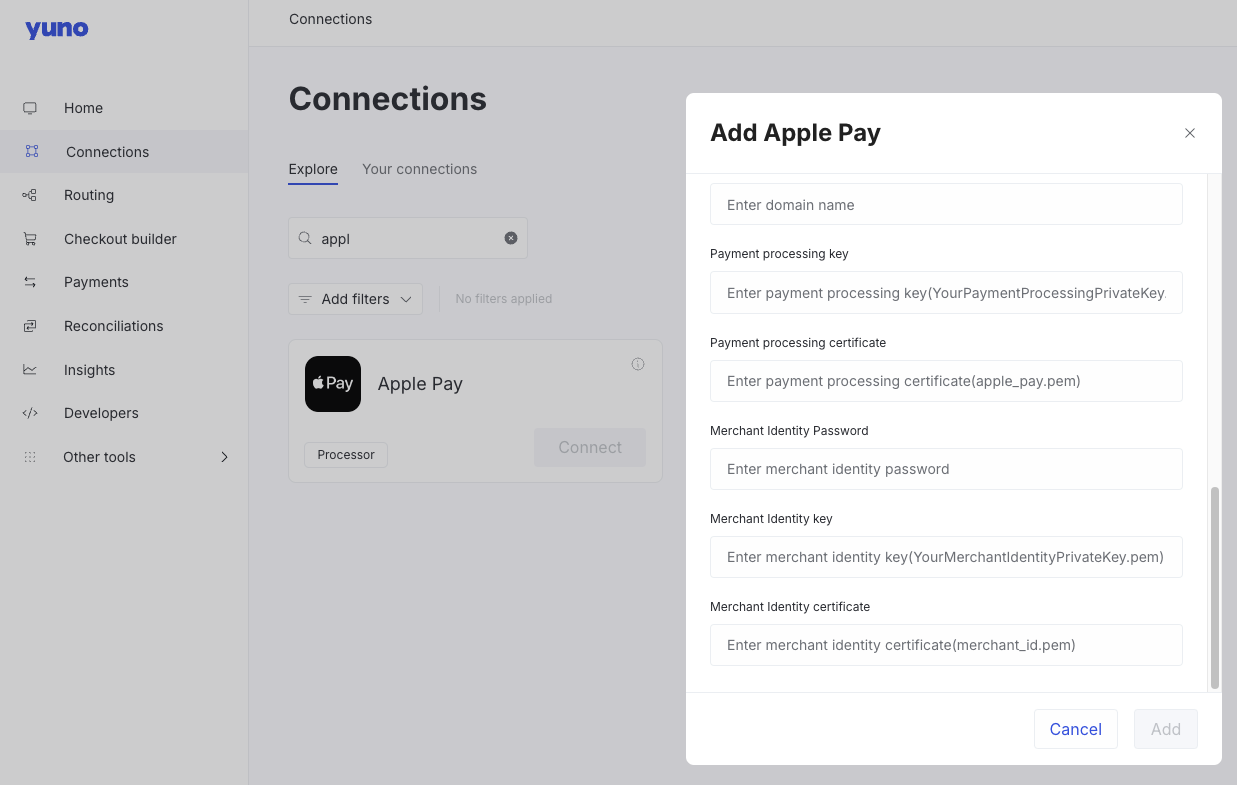
Step 6: Generate a merchant identity certificate
- Open Keychain Access, navigate to Certificate Assistant > Request a Certificate From a Certificate Authority, and enter:
- Email Address: your email
- Common Name: e.g.,
John Doe MerchantIdentityCertificate - Leave CA Email Address blank
- Select Saved to disk
- Save as
CertificateSigningRequestMerchantIdentityCertificate.certSigningRequest.
Step 7: Retrieve and convert the merchant identity certificate
- Go to the Apple Developer Merchant ID list.
- Select your Merchant ID and click Create Certificate under Apple Pay Merchant Identity Certificate.
- Upload the
CertificateSigningRequestMerchantIdentityCertificate.certSigningRequestfile. - Download the signed certificate as
merchant_id.cerand save it. - Convert it to PEM:
openssl x509 -inform DER -in merchant_id.cer -out merchant_id.pemStep 8: Export the merchant identity private key
- In Keychain Access, find the certificate created in step 6, e.g.
John Doe MerchantIdentityCertificate. - Right-click and export as
JohnDoeMerchantIdentityCertificate.p12. - Set a strong password.
- Convert the private key to PEM:
openssl pkcs12 -in JohnDoeMerchantIdentityCertificate.p12 -nocerts -nodes | sed -ne '/-BEGIN PRIVATE KEY-/,/-END PRIVATE KEY-/p' > MerchantIdentityCertificatePrivateKey.pemThe private key will be available as MerchantIdentityCertificatePrivateKey.pem.
Step 9: Upload the merchant identity certificate and key
- Return to your Apple Pay connection in the Yuno Dashboard.
- Copy the contents of
MerchantIdentityCertificatePrivateKey.pemand paste them into the Merchant Identity key field. - Paste the contents of
merchant_id.peminto the Merchant Identity certificate field.

Step 10: Register your merchant domains
- Go to Apple Developer Merchant ID list.
- Select your Merchant ID and click Add Domain under Merchant Domains.
- Enter the domain (e.g.,
demo.y.uno) and click Save.
NoteYou must also host Apple’s
apple-developer-merchantid-domain-associationfile at:https://yourdomain.com/.well-known/apple-developer-merchantid-domain-association
Once all steps are complete, you can proceed with the Dashboard setup.
Step 11: Apple Pay Dashboard connection
- Log in to your Yuno Dashboard.
- Navigate to the Connections section.
- Locate and select the Apple Pay option and click Connect.
- Provide a Name for the connection, select Apple Pay as Payment method, and provide the information you acquired when following the Prerequisites process, click Next.
- Configure set up costs (optional) and accounts in the following two steps.
- Click Save. Apple Pay will be added to your connections.
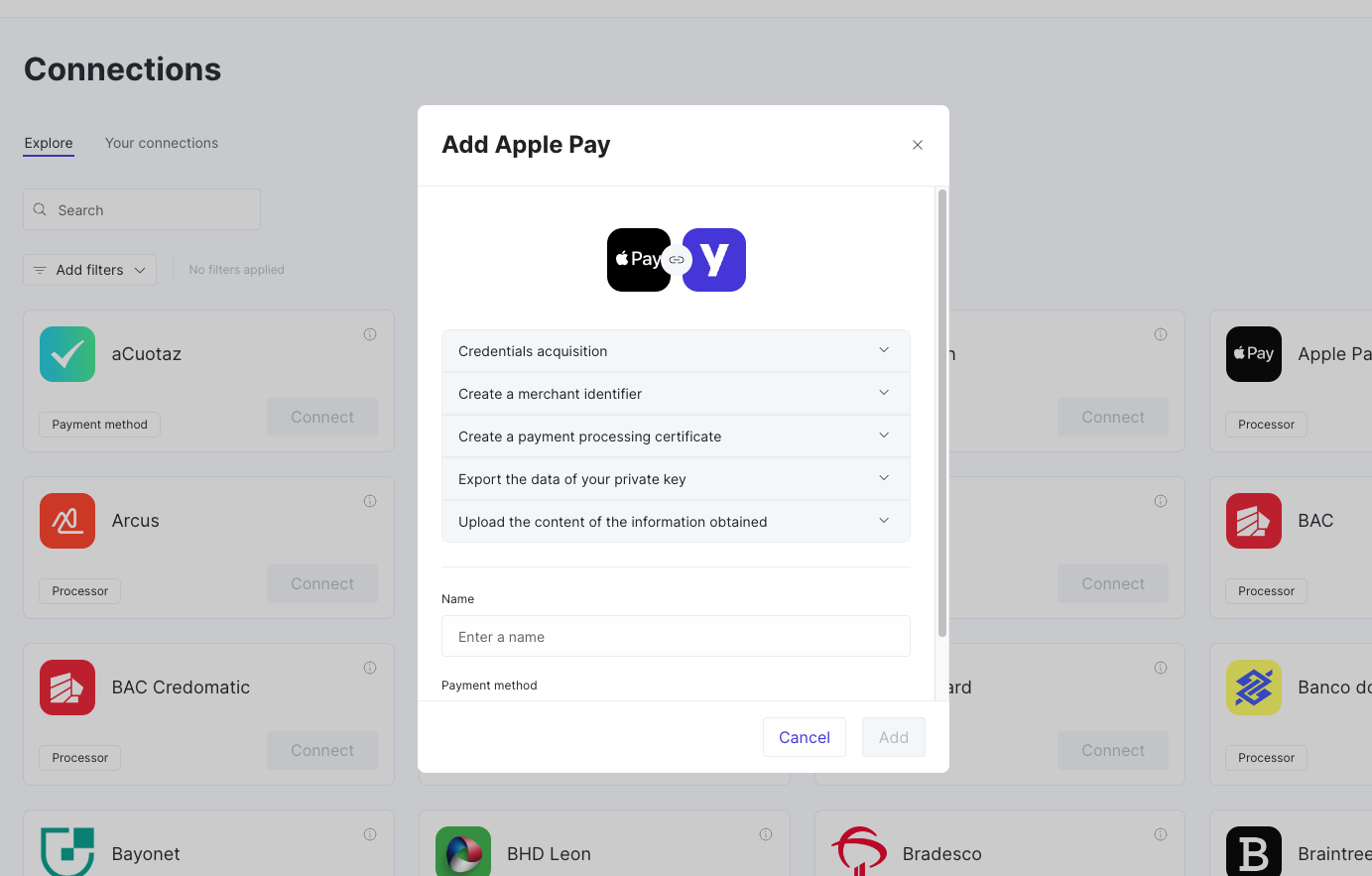
Step 12: Configure Dashboard routing
Set up a new route to control how payments are processed through Apple Pay.
Visit the Routing page for additional information on this step.
- In the Yuno Dashboard, navigate to the Routing section.
- Find the Apple Pay connection. If you have not created a route for Apple Pay yet, it will be on the Not published tab.
- Set up a new route by pressing Setup on your Apple Pay module (or View if the route is published) and then clicking on Create new route. Give the connection a name and click Save.
- Add conditions to specify how payments should be routed through Apple Pay.
- Add Apple Pay as the payment processor for this route to ensure that payments meeting the defined conditions are processed through Apple Pay.
- Publish the route once all configurations are defined.
Here's a simple route processing all payments through Apple Pay.
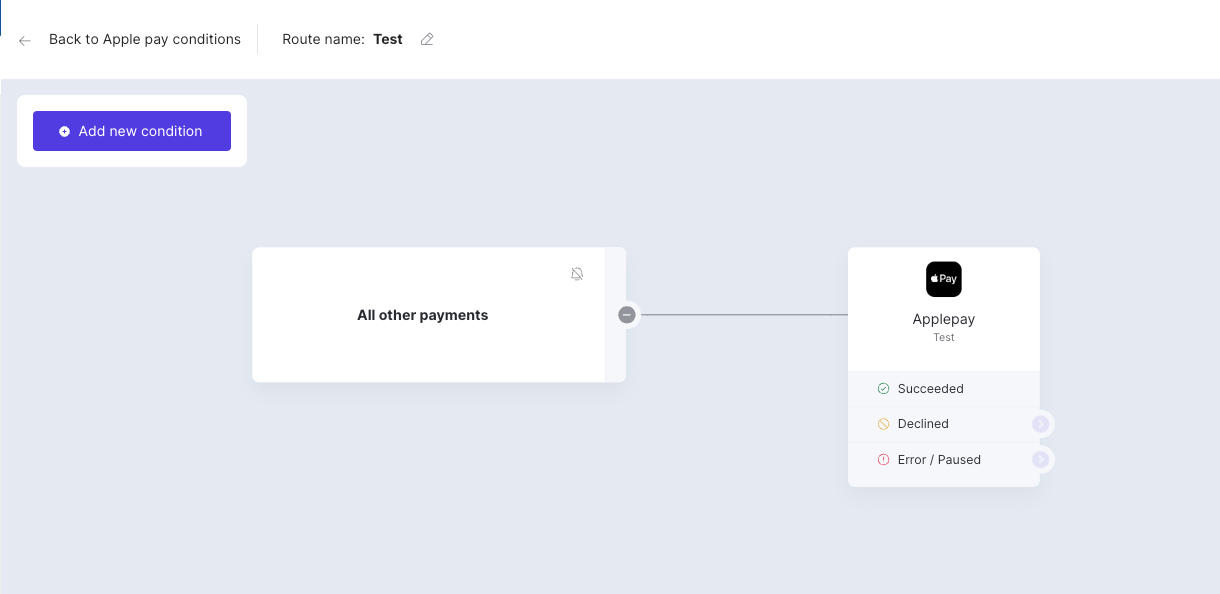
Step 13: Enable Apple Pay in Checkout Builder
Visit the Checkout Builder page for additional information on this step.
To make Apple Pay available to your end users, you have to enable it on the Checkout Builder:
- In the Yuno Dashboard, navigate to the Checkout Builder section.
- Locate the available Payment methods and enable Apple Pay. Click the three dots next to each method for additional options.
- Click Publish settings to make Apple Pay available as a payment option for all transactions that meet the defined routing criteria.
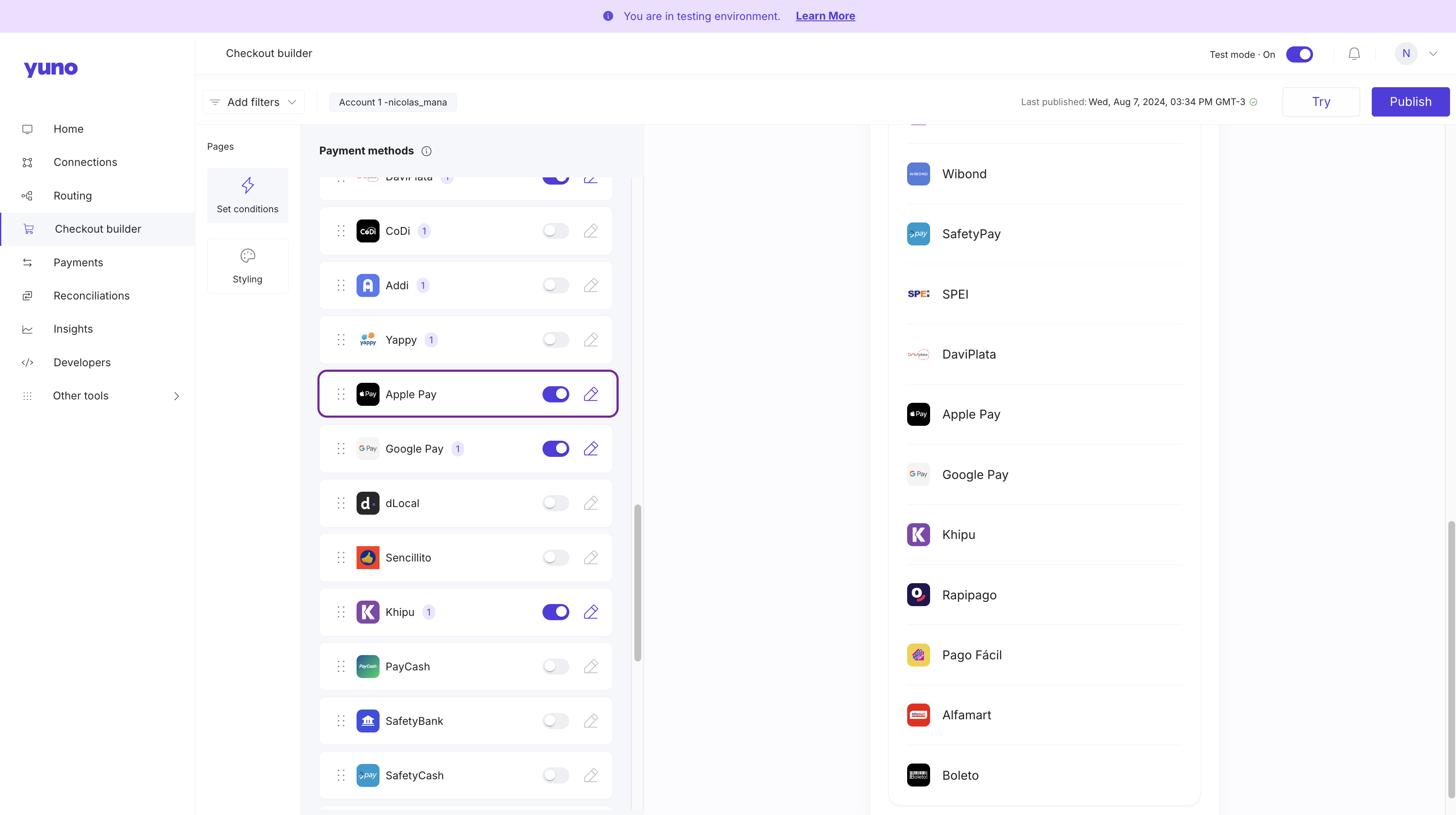
If you plan to implement recurring payments, you will need to configure an additional URL in your Apple Pay connection where customers can manage their subscriptions (cancel, modify, etc.). This URL must be created and hosted by your merchant platform.
Next steps
After completing the Dashboard setup, choose your path to integrate via SDK or Direct:
Updated 3 months ago